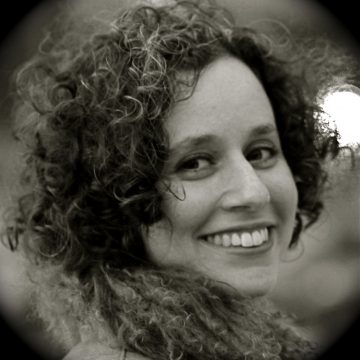
Biz 120: The Yiddish Artists and Friends Actors’ Club at 85
Amanda (Miryem-Khaye) Seigel
The first time I ascended the steep flight of stairs to the second floor of the Hebrew Actors’ Union building, I had the sense of entering a place frozen in time. Near the door stood a telephone booth with a handwritten list of Yiddish actors and their telephone numbers. The walls were covered with portraits of Yiddish stage stars. A bust of playwright Jacob Gordin presided over a giant, old-fashioned radio and an assortment of Yiddish books on low shelves. Old Chanukah decorations hung from the painted tin ceiling. A hodgepodge of vintage tables and chairs, arranged lengthwise, filled most of the hall. A banner with comedy-tragedy icons hung prominently at the front of the room: “YAFAC: Yidishe artistn un fraynd aktyorn-klub” (Yiddish Artists and Friends Actors’ Club).
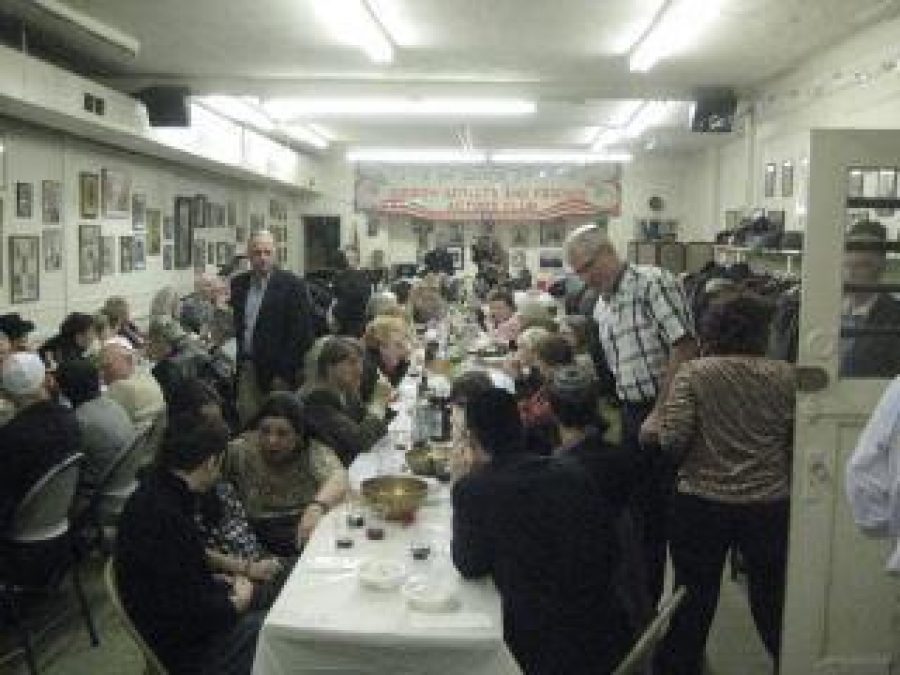
Standing, on right: Hy Wolfe, YAFAC Vice President.
I was amazed to find this antiquated space animated by the laughter and warm conversation of Yiddish theatre denizens, including many now-departed Yiddish actors of the older generation, such as David and Nina Rogow, Minna Bern, Shifra Lerer, Fyvush Finkel, and Esta Saltzman, whose witty remarks and anecdotes could fill many more articles.
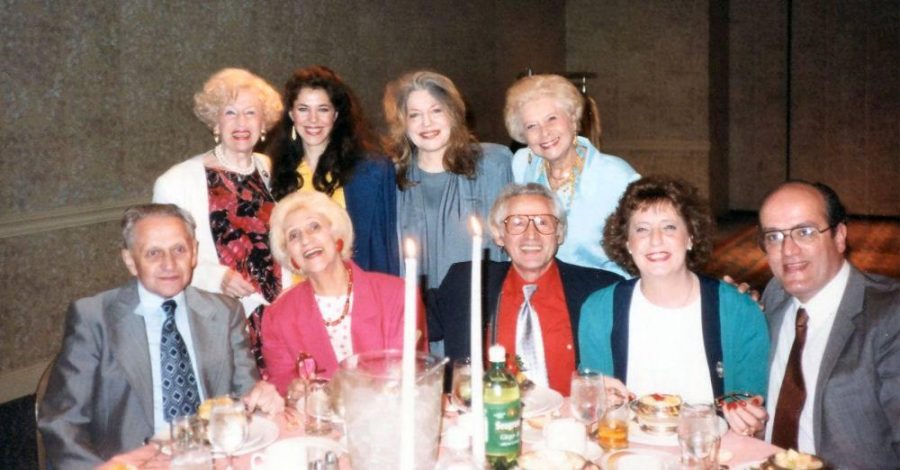
Top row, from left: Mina Bern, Shira Flam, Atara Hazan, and Shifra Lerer.
Bottom row, from left: Zalman Rogow, Nina Rogow, David Rogow, Shoshana Balaban Wolkowicz, and Horacio Wolkowicz.
Back then, attendance was by invitation only, in my case as a guest of members who were required to vouch for me. Once seated, it was hard to wriggle out from the closely packed tables cluttered with bowls of coleslaw, pickles, and seltzer. Harried waitstaff brought plates of kosher food from the club’s tiny kitchen, and circulated with bottles of liquor. According to YAFAC Vice President Hy Wolfe, he and other members, including Reyzel Breier, and the late Lena and Irving Glass, used to serve the food themselves.
The evening began with welcoming remarks in Yiddish and English, as the organization’s convivial president, Corey (Gedalye) Breier, proclaimed his nakhes at seeing a young person speaking Yiddish and reading the Forverts. Attendees rose to sing “Hatikvah” and “The Star-Spangled Banner” (the American flag near the stage had forty-eight stars), as trained, operatic voices rose dramatically above the rest. According to Hy, the Yiddish theatre pianist and music director Renee Solomon used to play the piano for YAFAC events; today, singer-pianist-bandleader Mitch Kahn fills this role. Hy also recalls late members like the singer-actor David Carrey (formerly Secretary), and Zypora Spaisman, who ran the Folksbiene, Claire Barry of the legendary Barry Sisters, and guests such as Joe Franklin from WEVD Radio and the actor Jerry Stiller. Once, I was star-struck by a rare appearance by retired Yiddish actress and recording artist Mary Soreanu, tsu lengere yor (more years to come).
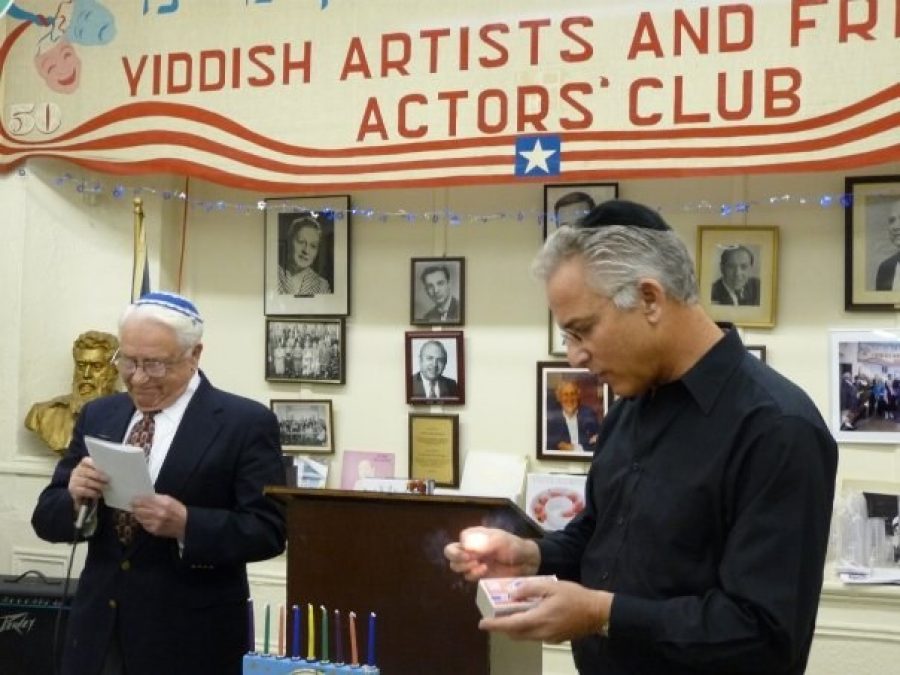
Mikhl Baran (left) and Corey (Gedalye) Brier (right) at a YAFAC pre-Chanukah celebration.
This was my introduction to YAFAC, one of the longest continually active Yiddish theatre organizations in the world. At 85, YAFAC still provides a friendly and supportive space for Yiddish actors, and for an expanded community of Yiddish theatre enthusiasts. Today, the club meets in a larger rented, wheelchair-accessible space, while the original building sits vacant, the focus of efforts by the Hebrew Actors Foundation to secure funding for a renovated and reimagined space. Gone are the beloved actors of the older generation, though their descendants, friends, and fans continue to attend, along with current Yiddish actors and musicians.
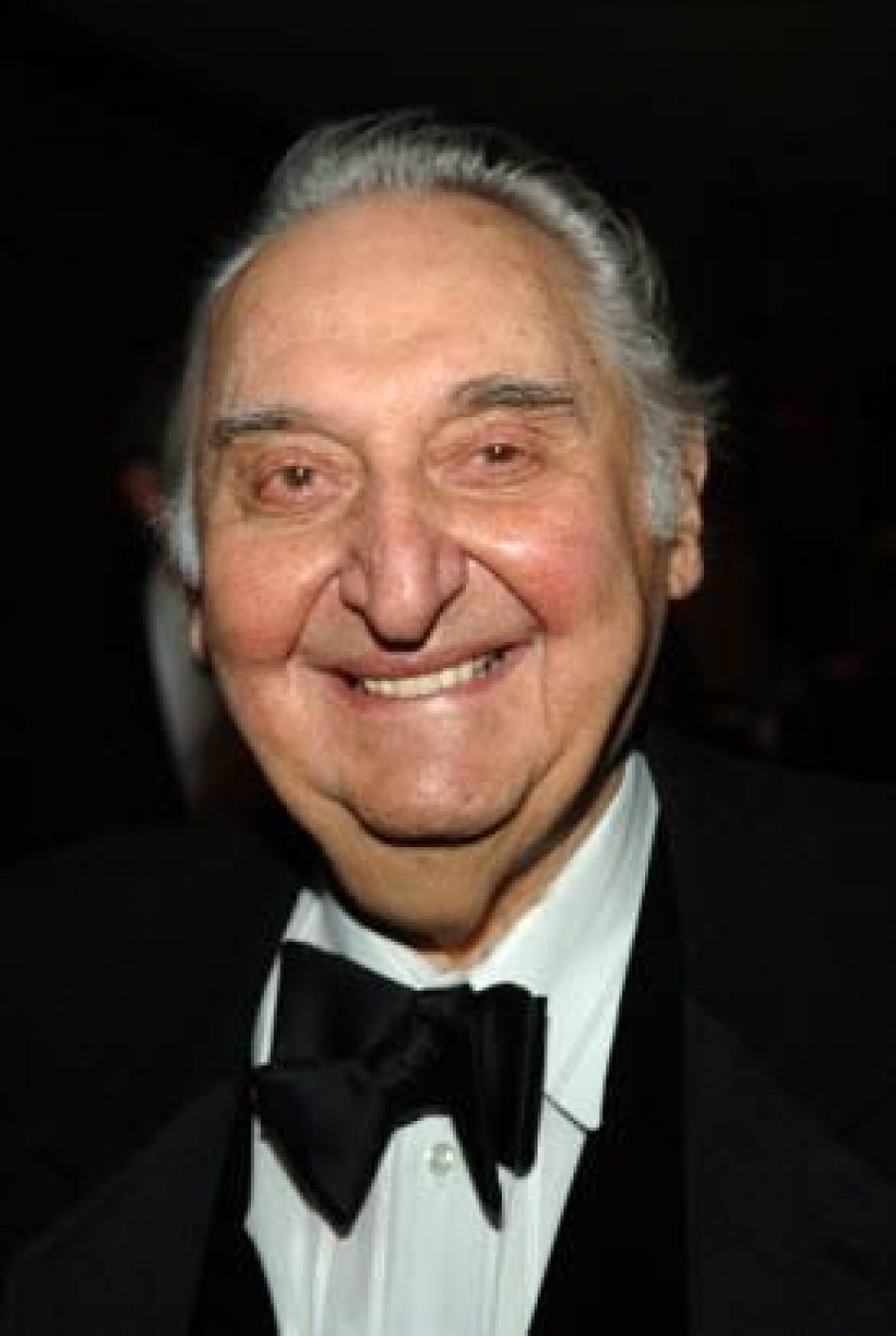
Fyvush Finkel (1922-2016).
For Yiddish theatre enthusiasts, the organization’s annual cemetery visit connects the past to the present. Each fall preceding the High Holidays, YAFAC visits the burial plots of the Yiddish Theatrical Alliance in Mount Hebron Cemetery in Flushing, NY. Here one finds the graves of Yiddish actors, musicians, writers and stage personnel—a veritable Who’s Who of Yiddish theatre in America. Visitors pay tribute to the Yiddish theatre personnel killed in the Holocaust; a cantor chants “El mole rakhamim” (merciful god”; Hebrew prayer for the soul of the departed) and everyone sings Hirsh Glik’s partisan hymn “Zog nit keyn mol.” Stones are placed on graves, and bronfn (liquor) and lekekh (cake) are served.
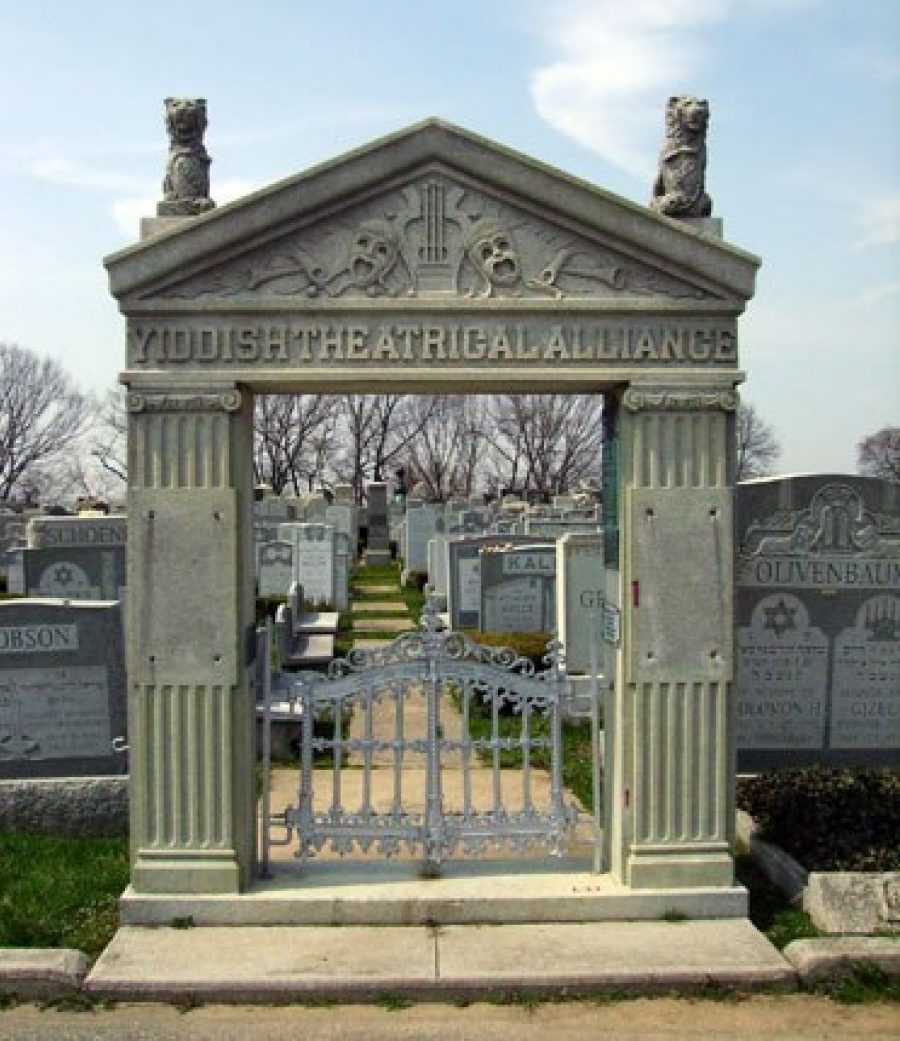
Gates to the Yiddish Theatrical Alliance at Mt. Hebron Cemetery, Flushing, NY.
The descendants of the Yiddish stars resting here continue the creative legacy: YAFAC members today include actors Mike Burstyn (son of Lillian Lux Burstein and Pesach’ke Burstein) and Rick Grossman (son of Diana Goldberg and Irving Grossman), and TV/stage/screen writer Melanie Mintz (granddaughter of lyricist, playwright and actor Jacob Jacobs and daughter of actress Thelma Mintz).
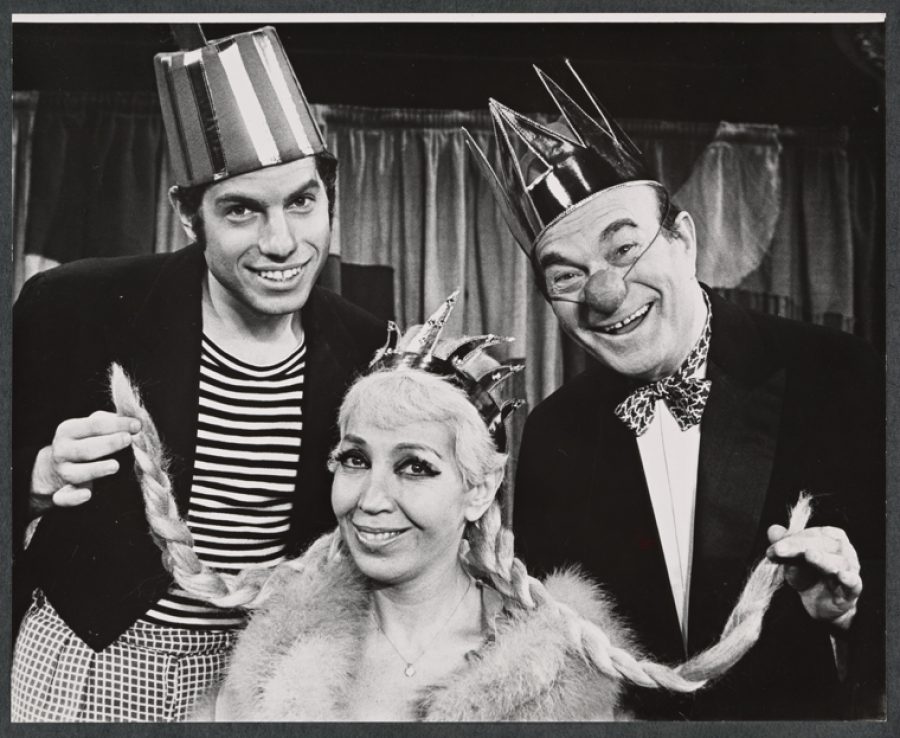
From left: Mike Burstyn, Lillian Lux, and Peysach’ke Burstein in The megillah of Itzik Manger (1968).
YAFAC: The Early Years
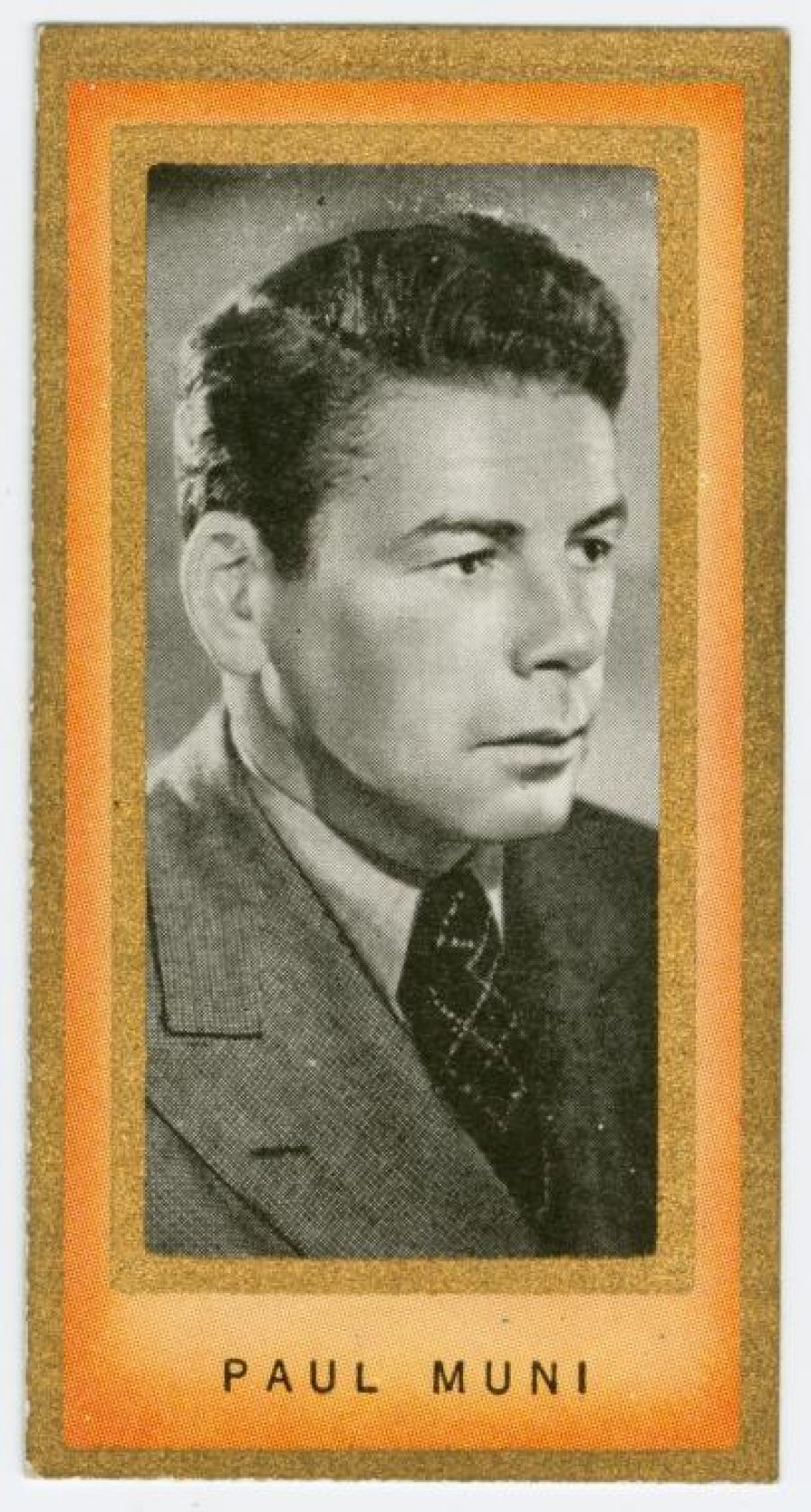
Zalmen Zylbercweig’s Leksikon fun yidishn teater (volume 3, pp. 2281–2284) describes the organization’s first twenty-five years. In 1932, Yiddish actor turned Hollywood star Paul Muni was performing in Counsellor-at-Law, when he wrote to Max Friedlander that he wanted to meet with the “boys” (his friends with whom he had performed Yiddish theatre in Chicago). They met on June 8, 1932, in Moscowitz and Lupowitz’s Romanian Restaurant after the show. In attendance were Dovid Yanover, Moyshe (Morrs) Dorf, Max Henig, Sam Gershtenberg, playwright Louis Freiman, Max Friedlander, Sam Gertler, Irving Grossman, Samuel H. Cohen, Irving Jacobson, David Denk, and writer M. (Mendel) Osherovits.
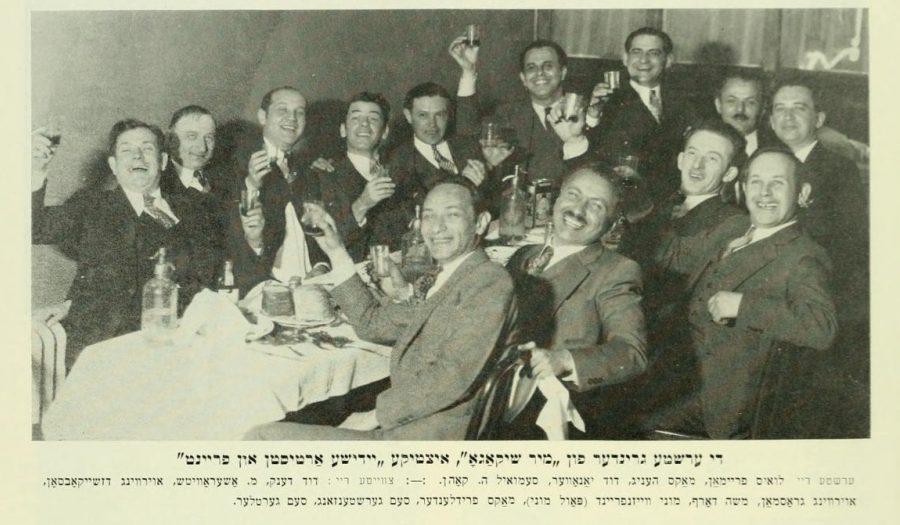
The First Founders.
First row: Louis Freiman, Max Henig, David Yanover, and Samuel H. Cohen.
Second Row: David Denk, M. Osherovits, Irving Jacobson, Irving Grossman, Moyshe (Morrs) Dorf, Paul Muni, Max Friedlander, Sam Gershtenberg, and Sam Gertler.
Three years later, after the death of Paul Muni’s mother (Yiddish actress Saltshe Vayzenfraynd), her second husband Morris Nestor returned from Los Angeles, and the idea of creating a club called “Mir Shikager” (We Chicagoans) was born.

Saltshe and Fayvl Vayzenfraynd.
The club was officially founded on January 17, 1935, in the Hebrew Actors’ Union building. The first administrators were elected unanimously: Paul Muni: Honorary President, Hymie Jacobson: President, Moyshe (Morris) Nestor: Vice-President, David Denk: Treasurer, Max Friedlander: Recording Secretary, and a three-person committee of Julius Nathanson, Max Henig, and Samuel H. Cohen.
The foundations of the club were:
- Chicagoan friends: all for one and one for all.
- Once a Chicagoan, always a Chicagoan.
- When, God forbid, a brother is in need, he can trust his brother.
- To share the last we have.
- From near and far, we will always be connected through letters, telegrams, or telephone.
- Help should come without investigation; the outside world should not know.
- Everyone should help to collect a fund for the organization in order to help its members.
- For a Chicago friend, nothing is too difficult
- From the other end of the world, a Chicago friend should be brought home.
- In sadness and joy, all Chicago friends should be together as one big family of friendship, solidarity, and brotherliness.
- The Chicago bond is from today until forever.
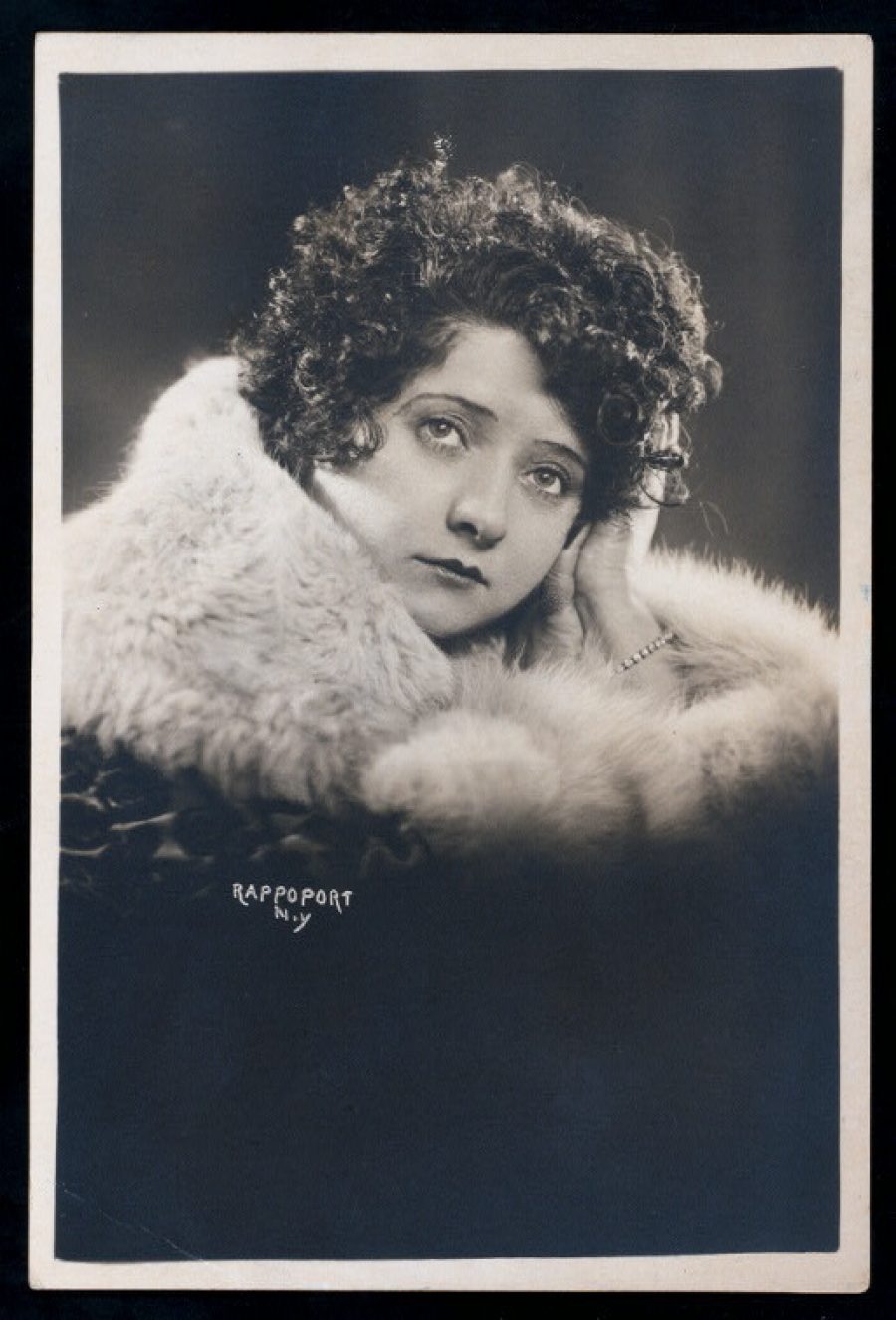
Jennie Goldstein (1896-1960).
On November 13, 1936, Irving Grossman was chosen as President and Samuel H. Cohen as Finance Secretary. The first Executive Board, chosen by secret ballot, was: Louis Freiman, Jennie Goldstein, Max Bozyk, Mikhl Mikhalesko, David Denk, and Jack Segal.
During Mikhalesko’s tenure, the name of the organization was changed to “Yidishe artistn un fraynd aktyorn-klub” (Yiddish Artists and Friends Actors’ Club, Inc.), to give all people of the profession the possibility of membership, and leaders included Max Henig, Joe Grossman, Abe Dorf, Jennie Cohen, Sam Gertler, and Arthur Winters. The later presidents were: Max Kletter, Herman Yablokoff, Misha German, Mikhl Mikhalesko, and Oscar Green.
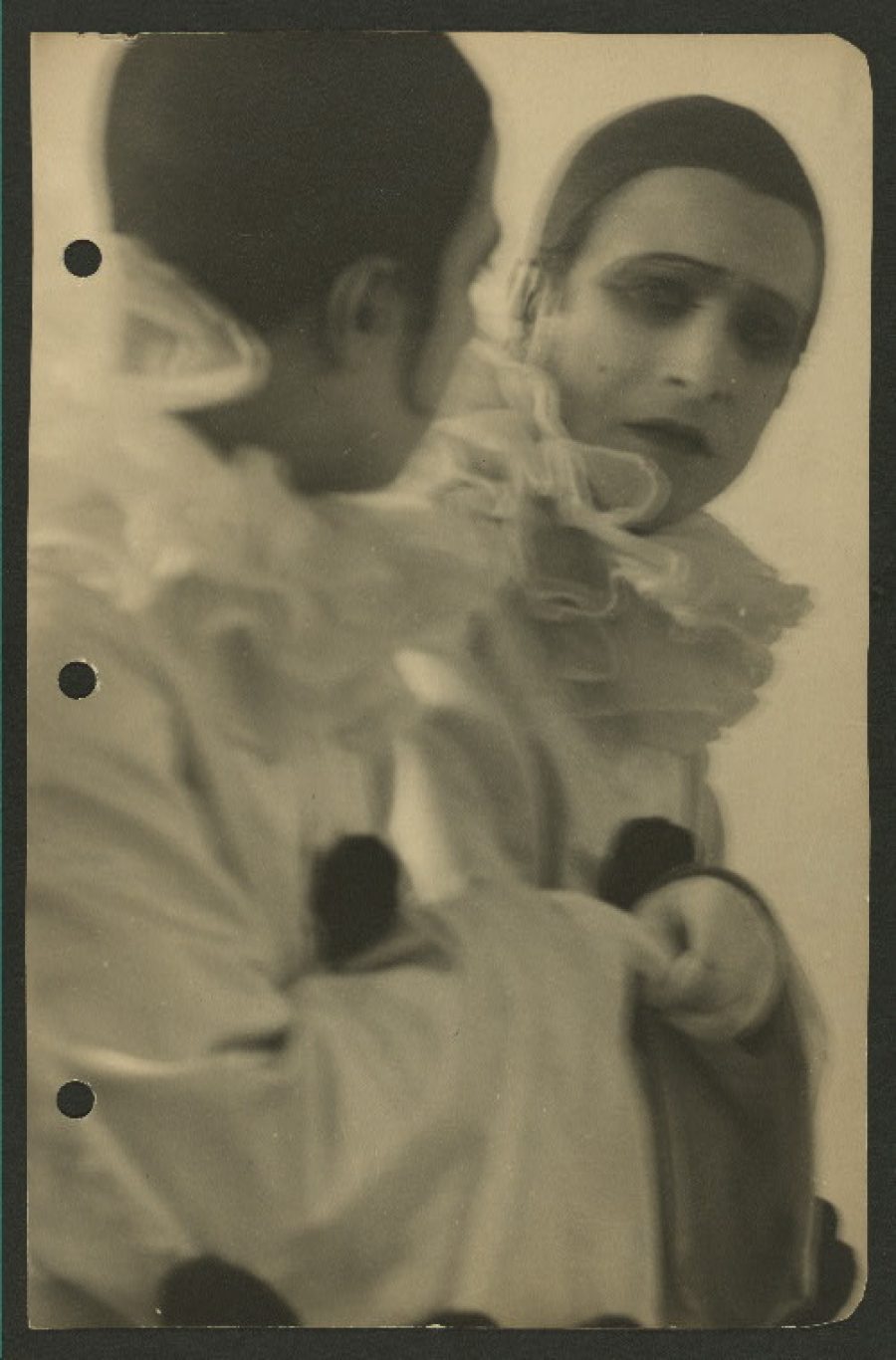
Herman Yablokoff (1903-1981).
The organization had a record of countless acts of help, such as anonymous gifts, to those in need. The board members of 1959-1960, who were preparing a twenty-fifth-year jubilee for the organization [at the time this entry was published], were: Jack Segal: President, Anna Tabak: Vice President, Morris Tarlovski: Recording Secretary, Shirley Segal: Finance Secretary, and Harry Was: Treasurer. The executive board consisted of: Mordechai Yachson: Secretary, Julius Adler, Sylvia (Fishman) Friedlander, Ida Green, Irving Jacobson, Phillip Laskowski, Charles Litt, Isaac Lipinsky, Israel Rosenberg, Lilly Satz, and Julius Vane. As an advisory committee were the former presidents: Max Bozyk, David Denk, Louis Freiman, Jennie Goldstein, and Oscar Green.
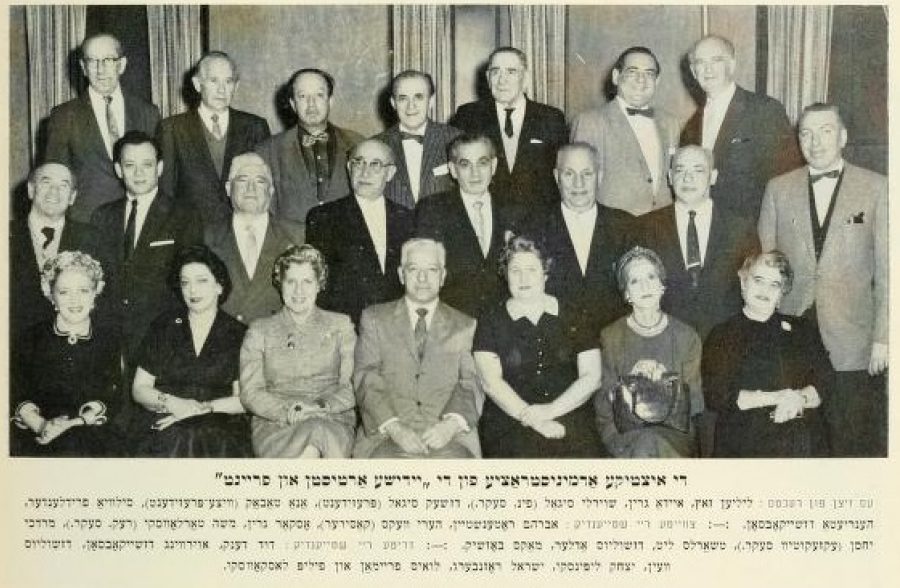
The current administration of “Yiddish Artists and Friends” (ca. 1959).
Seated, from right: Lillian Satz, Ida Green, Shirley Segal (Finance Secretary), Jack Segal (President), Anna Tabak (Vice President), Silvia Friedlander, and Henrietta Jacobson.
Second row, standing: Abraham Rotenstein, Harry Wex (Cashier), Oscar Green, and Moyshe (Morris) Tarlovski (Recording Secretary), Mordechai Yachson (Executive Secretary), Charles Litt, Julius Adler, Max Bozyk.
Third row, standing: David Denk, Irving Jacobson, Julius Vane, Isaac Lipinsky, Israel Rosenberg, Louis Freiman, and Phillip Laskowsky.
Continuing the legacy
Today, YAFAC still holds seasonal events. Most recently, there was a Molly Picon tribute concert that was held in cooperation with the Yiddish New York festival. These events are largely produced by tireless volunteers, especially longtime President Corey (Gedalye) Breier, Vice President Hy Wolfe, Correspondence Secretary Ruth Harris, and her spouse Steven Harris, YAFAC’s resident piano tuner.
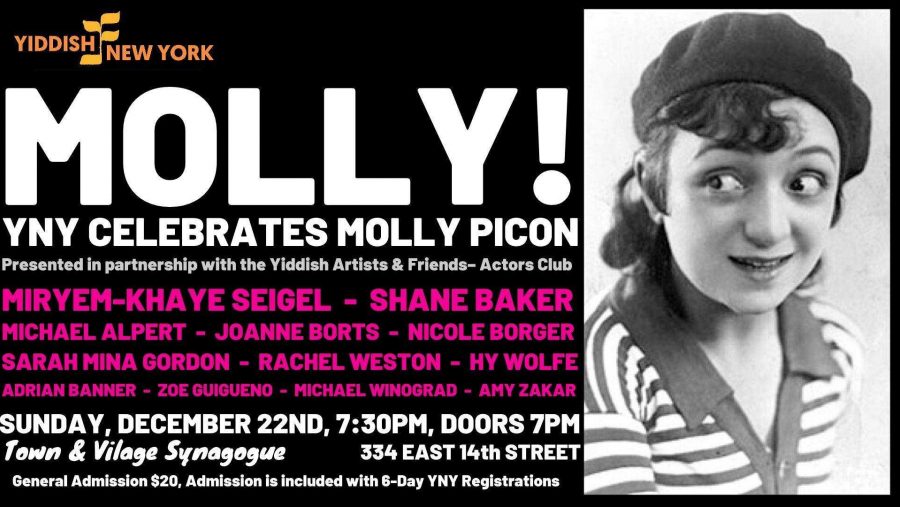
Every spring (this year on Tuesday, March 31), the YAFAC Yiddish cultural pre-Passover seder draws a crowd of approximately 150 people in an interactive event by turns hilarious and solemn. Guests read Yiddish and English texts from the Workers’ Circle’s hagode, and sing Yiddish Passover songs together, led by Cantor Moshe Bear with pianist Alex Rubinstein. A glatt kosher Peysekh-style meal is served. Guest artists perform songs. The community memorializes those killed in the Holocaust and candles are lit by survivors and their descendants as “Ani ma’amin” is chanted. In recent years, a gift by the late Nina Rogow has sponsored the participation of young Yiddish speakers in the seder to aid in the Yiddish readings. The evening ends on a joyous note with music and dancing.
Concluding dance at the 2019 YAFAC seder.
At 85, YAFAC is still going strong. To learn more about the annual pre-Passover Yiddish Cultural Seder on Tuesday, March 31, 2020. visit the YAFAC Facebook page.
